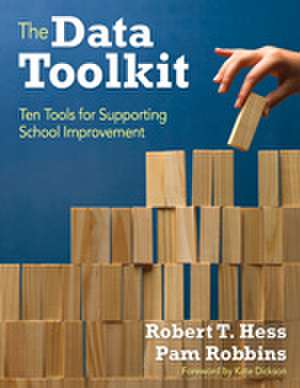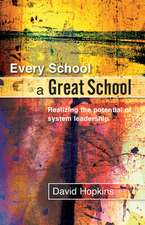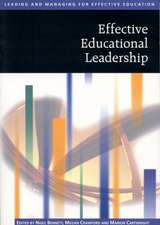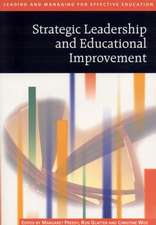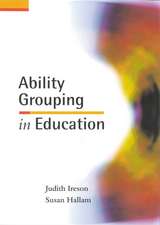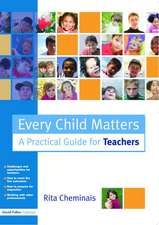The Data Toolkit: Ten Tools for Supporting School Improvement
Autor Robert T. Hess, Pamela M. Robbinsen Limba Engleză Paperback – 18 ian 2012
- Frame the questions
- Drive the conversation
- Engage in productive reflection
- Uncover understandings
- Create a data-driven plan
- Achieve and monitor results
Written in an educator-friendly format each chapter contains instructions on using the tool, a sample scenario, and examples—practical tools that will help your PLC be the best it can be.
Also included are case studies that show how data teams, PLCs, and individual teachers have used the book's methods in their own settings. The culminating school improvement mapping tool guides the team through designing an action plan focused on increasing student learning and achievement outcomes.
Preț: 250.39 lei
Nou
Puncte Express: 376
Preț estimativ în valută:
47.91€ • 52.21$ • 40.37£
47.91€ • 52.21$ • 40.37£
Carte tipărită la comandă
Livrare economică 23 aprilie-07 mai
Preluare comenzi: 021 569.72.76
Specificații
ISBN-13: 9781412992978
ISBN-10: 1412992974
Pagini: 160
Dimensiuni: 216 x 279 x 15 mm
Greutate: 0.43 kg
Ediția:1
Editura: SAGE Publications
Colecția Corwin
Locul publicării:Thousand Oaks, United States
ISBN-10: 1412992974
Pagini: 160
Dimensiuni: 216 x 279 x 15 mm
Greutate: 0.43 kg
Ediția:1
Editura: SAGE Publications
Colecția Corwin
Locul publicării:Thousand Oaks, United States
Recenzii
“An invaluable resource for teachers and school leaders; a sensible, practical, and human approach to understanding and using data; an excellent guide to use a broad range of data meaningfully for the improvement of education.”
“Finally, a book that treats data as more than a set of percentages!”
“This book is filled with great strategies to establish and grow a school’s data team, bringing them from ordinary to extraordinary.”
“Many districts and schools are approaching school improvement by implementing bits and pieces of data work without understanding how to build a foundation beneath the practices. This book provides practical and effective tools that can strengthen any improvement program through the efficient use of both quantitative and qualitative data.”
“We’ve been talking data, producing data, collecting data, analyzing data, and using data to drive instruction for over ten years. But most of us in the field still don't really know how to do that. This book shows teachers and school leaders how to use data to improve student learning.”
“I am excited to say that educators finally have a book that provides a practical toolkit to help increase data fluency and begin using it to foster students’ growth. The authors provide precise tools for drilling down into the data and using it in a way that benefits our students.”
"This book does for educators what a great teacher does for students: it motivates and instructs. Rob and Pam deliver powerful concepts in a very accessible way. They provide a logical framework for educators to work through tough problems while building energy and motivation."
"This practical toolkit takes an educator from data parlysis to data analysis. Hess and Robbins have assembled a masterful resource of templates, facilitation tips, data analysis instruments and examples of achievement success. There is something of value for every teacher, principal or superintendent who endeavors to improve student performance."
“This practical and insightful guidebook provides tools for principals and teacher leaders to facilitate the cycle of continuous improvement and achieve gains in both student and staff learning. Rob Hess and Pam Robbins have synthesized best practices from both research and the field that are both balanced and comprehensive.”
“Finally, a book that treats data as more than a set of percentages!”
“This book is filled with great strategies to establish and grow a school’s data team, bringing them from ordinary to extraordinary.”
“Many districts and schools are approaching school improvement by implementing bits and pieces of data work without understanding how to build a foundation beneath the practices. This book provides practical and effective tools that can strengthen any improvement program through the efficient use of both quantitative and qualitative data.”
“We’ve been talking data, producing data, collecting data, analyzing data, and using data to drive instruction for over ten years. But most of us in the field still don't really know how to do that. This book shows teachers and school leaders how to use data to improve student learning.”
“I am excited to say that educators finally have a book that provides a practical toolkit to help increase data fluency and begin using it to foster students’ growth. The authors provide precise tools for drilling down into the data and using it in a way that benefits our students.”
"This book does for educators what a great teacher does for students: it motivates and instructs. Rob and Pam deliver powerful concepts in a very accessible way. They provide a logical framework for educators to work through tough problems while building energy and motivation."
"This practical toolkit takes an educator from data parlysis to data analysis. Hess and Robbins have assembled a masterful resource of templates, facilitation tips, data analysis instruments and examples of achievement success. There is something of value for every teacher, principal or superintendent who endeavors to improve student performance."
“This practical and insightful guidebook provides tools for principals and teacher leaders to facilitate the cycle of continuous improvement and achieve gains in both student and staff learning. Rob Hess and Pam Robbins have synthesized best practices from both research and the field that are both balanced and comprehensive.”
Cuprins
Foreword by Kate Dickson
Preface
Acknowledgments
About the Authors
Introduction
Chapter 1: Build Your Team
The Power of Relationships
Tool 1: The Smalley Team-Building Personality Test
Another Team-Building Strategy: Using Objects to Reflect Personalities
High-Functioning Teams
Improvement Means Change, and Change Means Conflict
Understanding How Change Occurs
Team Member Roles and Responsibilities
TIPS Framework for Data Teams
Additional Helpful Hints
Chapter 2: Identify the Problem: Using Data to Transform Our Intentions
Tool 2: Identify the Problem
Using Data to Unpack the Problem of Mobility
Vertical Alignment and Mobility
Using Identify the Problem in a Classroom
Data Reflection Helps Budget Woes
A Happy Ending to Budget Woes
In the Field: Identify the Problem
Putting It All Together
Chapter 3: The Three Guiding Questions: Making Instruction Work
Data and Conversation
Tool 3: Three Guiding Questions
How to Use Three Guiding Questions
Asking the Right Questions
The Power of Thinking
Corbett: A District That Thinks
Conversation Promotes Thinking and Reflection
In the Field: Three Guiding Questions
Putting It All Together
Chapter 4: Analyze Your Students: Let the Data Decide
Teach to the Top
Analyzing Driving Quantitatively
Creating the Standard
Measuring to a Standard
The Kennewick Model
Analyzing Students in Local Districts
Classroom Example
In the Field: A Kindergarten Success
Putting It All Together
Chapter 5: Four Quadrants: Creating Crosshairs With Data
Tool 5: Four Quadrants: Creating Crosshairs With Data
Reeves's Four Quadrants: Lucky, Leader, Loser, and Learner
Using the Four Quadrants to Gauge RTI Progress
Using the Four Quadrants to Analyze Classroom Data
Classroom Example: Third-Grade Classroom Data in Four Quadrants
Using the Four Quadrants to Analyze Grade-Level, School-Level, and District-Level Data
Teacher and Principal Effectiveness in Four Quadrants
Instructional Leadership Standards for Principals
Building Management Standards for Principals
Teacher Effectiveness in the Four Quadrants
Classroom-Based Instructional Standards
Non-Classroom-Based Standards
In The Field: Analyzing Freshman Failures
Putting It All Together
Chapter 6: Wagon Wheel: Using Multiple Points of Data to Drive Instruction
Tool 6: Wagon Wheel
Mapping Fourth-Grade Writing on the Wagon Wheel
Reflecting on the Data
Using the Wagon Wheel to Measure InTASC Standards
Learner and Learning
Content Knowledge
Instructional Practice
Professional Responsibility
In The Field: Using the Wagon Wheel to Analyze RTI Effectiveness
Putting It All Together
Chapter 7: Five Whys: The Power of Questions
Tool 7: Five Whys
Persistent Achievement Gaps
A Diverse District Beating the Odds
Schools Beating the Odds
The Power of Working Together
Teaching Students to Think
21st Century Skills: The Future is Now
In The Field: Implementing a Core Program
Putting It All Together
Chapter 8: Relations Diagram: Discovering the Key Drivers
Tool 8: Relations Diagram
Tackling Discipline Problems
Motivating Students
In The Field: READ 180 Revisited
Putting It All Together
Chapter 9: The Fishbone: Making a Difference With Data
Leadership Matters
Real Education Reform
Making a Difference in the Classroom
Tool 9: The Fishbone
Improving Tenth-Grade Math Scores
Everyone Writes
In The Field: Green Acres, The Place to Be
Putting It All Together
Chapter 10: School Improvement Mapping: Making Strategic Decisions and Taking Action
Tool 10: School Improvement Mapping
Goal Setting
Using Data to Drive Goals
Clear Strategies
Specific Actions
Improving Writing Districtwide with Goals, Strategies, and Actions
Creating the Building Blocks of Excellence
Hiring the Best
Professional Development
Evaluation for Meaningful Feedback
Improving Instructional Feedback
The Power of Mentoring as an Improvement Tool
Moving to the Next Level: A New Model of Systemic Improvement
Running in Circles
Collaboration = Connectivity
Stepping Up to Collaboration
In The Field: High School Mentoring Project
Putting It All Together
11. Now What? Using the Tools in the Classroom, School, and District
Tool 1: The Smalley Team-Building Personality Test
Tool 2: Identify the Problem
Tool 3: Three Guiding Questions
Tool 4: Analyze Your Students
Tool 5: Four Quadrants
Tool 6: Wagon Wheel
Tool 7: Five Whys
Tool 8: Relations Diagram
Tool 9: The Fishbone
Tool 10: School Improvement Mapping
References
Index
Notă biografică
Descriere
The authors provide ten easy-to-use data analysis tools that facilitate problem-solving at school and district levels. Included are instructions, sample scenarios and case studies.
